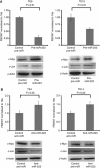Overexpression of microRNA-223 regulates the ubiquitin ligase FBXW7 in oesophageal squamous cell carcinoma
- PMID: 22108521
- PMCID: PMC3251856
- DOI: 10.1038/bjc.2011.509
Overexpression of microRNA-223 regulates the ubiquitin ligase FBXW7 in oesophageal squamous cell carcinoma
Abstract
Background: F-box and WD repeat domain-containing 7 (FBXW7) is a cell cycle regulatory gene whose protein product ubiquitinates positive cell cycle regulators such as c-Myc, cyclin E, and c-Jun, thereby acting as a tumour-suppressor gene. This study focused on microRNA-223 (miR-223), which is a candidate regulator of FBXW7 mRNA. The aim of this study was to clarify the clinical significance of miR-223 and FBXW7 in oesophageal squamous cell carcinoma (ESCC) patients, and to elucidate the mechanism by which FBXW7 is regulated by miR-223.
Methods: The expression levels of miR-223 and the expression of FBXW7 protein was examined using 109 resected specimens to determine the clinicopathological significance. We also investigated the role of miR-223 in the regulation of FBXW7 expression in ESCC cell lines in an in vitro analysis.
Results: We found that miR-223 expression was significantly higher in cancerous tissues than in the corresponding normal tissues. There was a significant inverse relationship between the expression levels of miR-223 and FBXW7 protein. Moreover, patients with high miR-223 expression demonstrated a significantly poorer prognosis than those with low expression. On the basis of a series of gain-of-function and loss-of-function studies in vitro, we identified FBXW7 as a functional downstream target of miR-223.
Conclusion: Our present study indicates that high expression of miR-223 had a significant adverse impact on the survival of ESCC patients through repression of the function of FBXW7.
Figures




Similar articles
-
[Expression of FBXW7 in esophageal squamous cell carcinoma and its clinical significance].Zhonghua Zhong Liu Za Zhi. 2015 May;37(5):347-51. Zhonghua Zhong Liu Za Zhi. 2015. PMID: 26463024 Chinese.
-
MicroRNA-25 promotes gastric cancer proliferation, invasion, and migration by directly targeting F-box and WD-40 Domain Protein 7, FBXW7.Tumour Biol. 2015 Sep;36(10):7831-40. doi: 10.1007/s13277-015-3510-3. Epub 2015 May 6. Tumour Biol. 2015. PMID: 25944166
-
Copy number loss of FBXW7 is related to gene expression and poor prognosis in esophageal squamous cell carcinoma.Int J Oncol. 2012 Jul;41(1):253-9. doi: 10.3892/ijo.2012.1436. Epub 2012 Apr 19. Int J Oncol. 2012. PMID: 22576686
-
Regulation mechanism of Fbxw7-related signaling pathways (Review).Oncol Rep. 2015 Nov;34(5):2215-24. doi: 10.3892/or.2015.4227. Epub 2015 Aug 26. Oncol Rep. 2015. PMID: 26324296 Review.
-
Aberrant regulation of FBW7 in cancer.Oncotarget. 2014 Apr 30;5(8):2000-15. doi: 10.18632/oncotarget.1859. Oncotarget. 2014. PMID: 24899581 Free PMC article. Review.
Cited by
-
miR-223: infection, inflammation and cancer.J Intern Med. 2013 Sep;274(3):215-26. doi: 10.1111/joim.12099. Epub 2013 Jun 25. J Intern Med. 2013. PMID: 23772809 Free PMC article. Review.
-
F-box protein FBXO31 is down-regulated in gastric cancer and negatively regulated by miR-17 and miR-20a.Oncotarget. 2014 Aug 15;5(15):6178-90. doi: 10.18632/oncotarget.2183. Oncotarget. 2014. PMID: 25115392 Free PMC article.
-
Role of microRNA-363 during tumor progression and invasion.J Physiol Biochem. 2024 Aug;80(3):481-499. doi: 10.1007/s13105-024-01022-1. Epub 2024 May 1. J Physiol Biochem. 2024. PMID: 38691273 Review.
-
Noncoding RNA Expression Aberration Is Associated with Cancer Progression and Is a Potential Biomarker in Esophageal Squamous Cell Carcinoma.Int J Mol Sci. 2015 Nov 24;16(11):27824-34. doi: 10.3390/ijms161126060. Int J Mol Sci. 2015. PMID: 26610479 Free PMC article. Review.
-
C/EBP-β-activated microRNA-223 promotes tumour growth through targeting RASA1 in human colorectal cancer.Br J Cancer. 2015 Apr 28;112(9):1491-500. doi: 10.1038/bjc.2015.107. Epub 2015 Mar 31. Br J Cancer. 2015. PMID: 25867276 Free PMC article.
References
-
- Ambros V (2004) The functions of animal microRNAs. Nature 431(7006): 350–355 - PubMed
-
- Bitzer M, Stahl M, Arjumand J, Rees M, Klump B, Heep H, Gabbert HE, Sarbia M (2003) C-myc gene amplification in different stages of oesophageal squamous cell carcinoma: prognostic value in relation to treatment modality. Anticancer Res 23(2B): 1489–1493 - PubMed
-
- Bloomston M, Frankel WL, Petrocca F, Volinia S, Alder H, Hagan JP, Liu CG, Bhatt D, Taccioli C, Croce CM (2007) MicroRNA expression patterns to differentiate pancreatic adenocarcinoma from normal pancreas and chronic pancreatitis. JAMA 297(17): 1901–1908 - PubMed
-
- Bredel M, Bredel C, Juric D, Harsh GR, Vogel H, Recht LD, Sikic BI (2005) Functional network analysis reveals extended gliomagenesis pathway maps and three novel MYC-interacting genes in human gliomas. Cancer Res 65(19): 8679–8689 - PubMed
-
- Calin GA, Liu CG, Sevignani C, Ferracin M, Felli N, Dumitru CD, Shimizu M, Cimmino A, Zupo S, Dono M, Dell’Aquila ML, Alder H, Rassenti L, Kipps TJ, Bullrich F, Negrini M, Croce CM (2004) MicroRNA profiling reveals distinct signatures in B cell chronic lymphocytic leukemias. Proc Natl Acad Sci USA 101(32): 11755–11760 - PMC - PubMed
Publication types
MeSH terms
Substances
LinkOut - more resources
Full Text Sources
Medical
Miscellaneous

